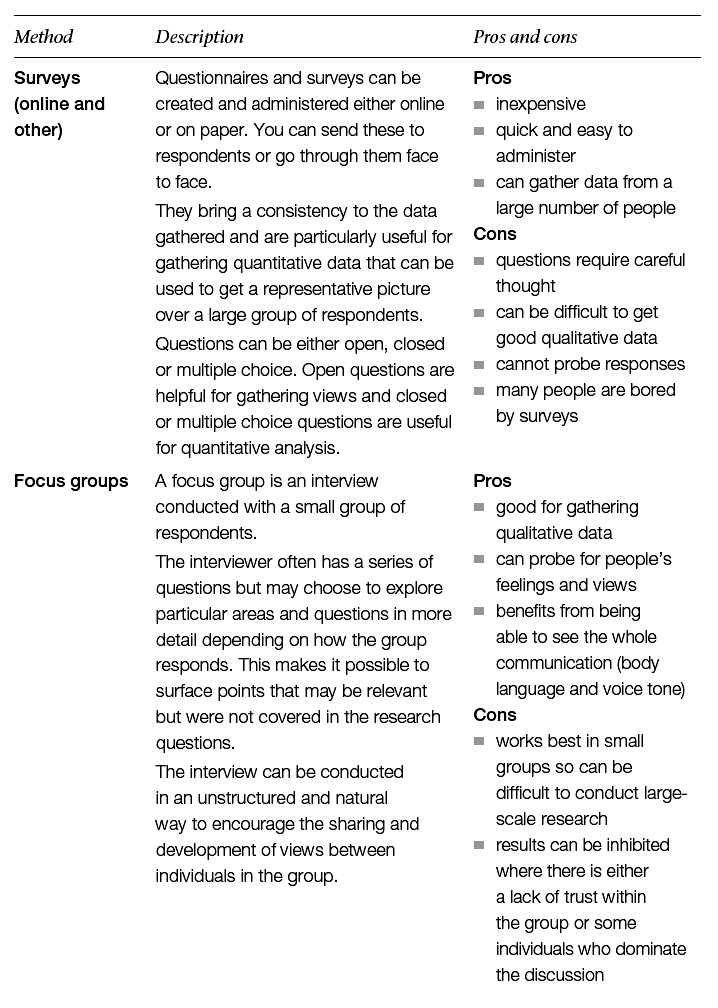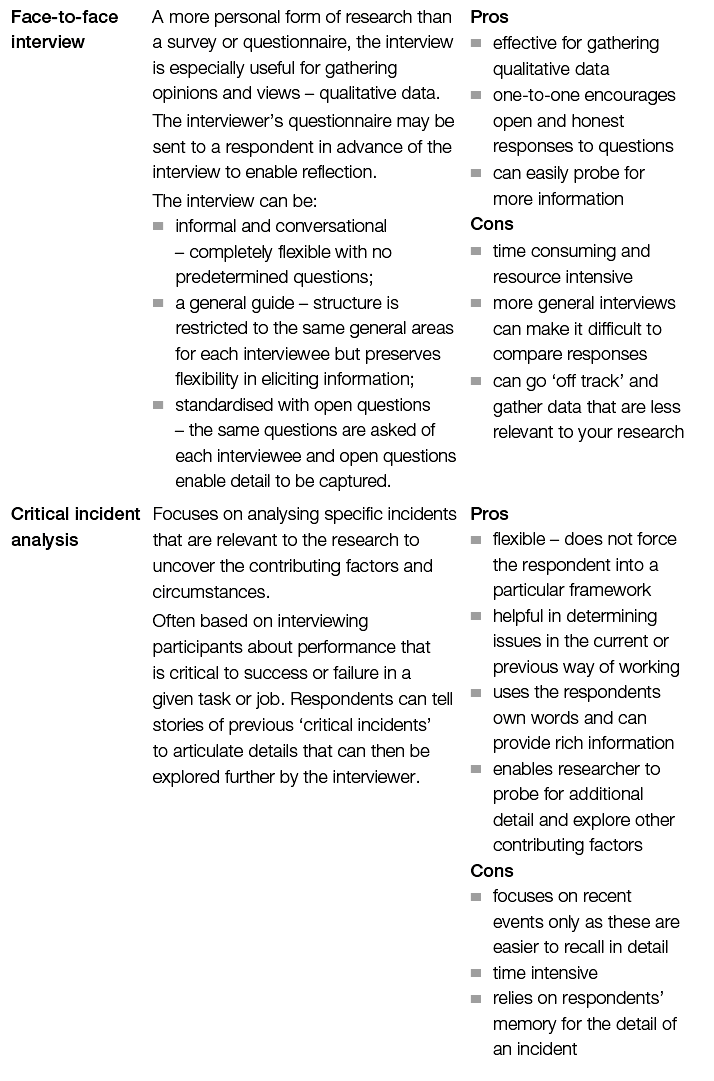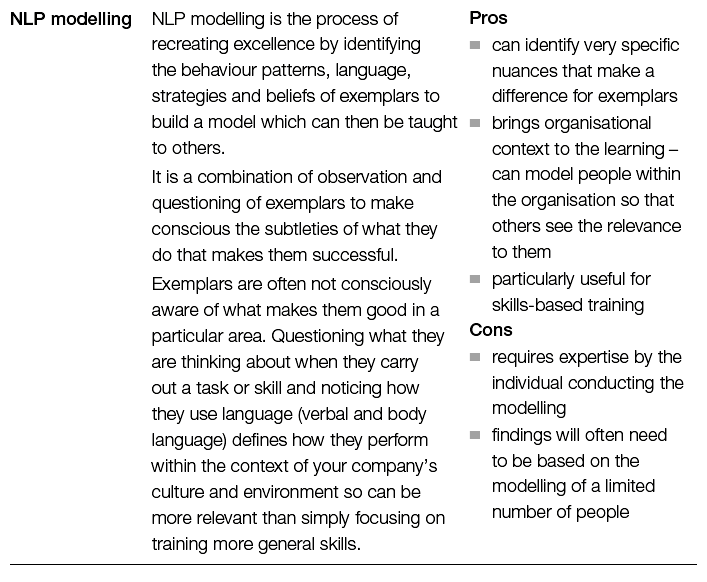Carrying out practical research
The word ‘research’ has its origin in obsolete French from the late sixteenth century and it literally means ‘intensive search’. You engage in research to establish facts and reach conclusions. Our experience of business training within many organisations around the world is that not enough research is carried out into the needs of participants and what exactly is required to ensure learning transfer. This leads to training being less effective than it could be and is a factor in explaining why only 5–10% of the annual expenditure on training results in improved workplace performance (The Kite Foundation, 2012).
Research is your opportunity to:
- ensure you design a training programme that focuses on the right things;
- give participants a voice in what is trained;
- gain their buy-in to the training;
- build a compelling and objective case for the training that you can substantiate to senior management;
- identify what else, in addition to the training, is needed to ensure the learning is transferred to the work environment;
- avoid working on assumptions that may be incorrect.
With all of these benefits there are compelling reasons for conducting effective and comprehensive research but you might have a number of questions as you consider the topic:
- What should I research?
- How do I maximise the effectiveness of my research with limited time and resources available?
- What methods and frameworks should I use?
- How many people should I research and how should I choose them?
You might also have some practical constraints on the research you can carry out:
- short timescales might prohibit comprehensive research;
- the budget available might limit your research;
- the nature of the project might make gathering objective data difficult.
Whatever opportunities and constraints exist, this chapter will give you the information you need to take a pragmatic approach to your research.
Researching the right things
The starting point for effective research is to look at the right things so let us identify what these are. Remember that your research is in service of achieving the business outcomes. This requires you to consider:
- what you want to achieve – the business outcome;
- where you are right now – the existing state;
- what you need in order to achieve the business outcome – what needs to change.
We have worked in organisations where the research phase has focused only on defining what content needed to be included within the training. This fails to recognise that training exists as part of a system with many other factors contributing to achievement of the business outcomes. Your research must take account of the whole system.
In order to identify what is needed to achieve the business outcome, your research must consider:
- The change required: what is it that needs to be changed, achieved, improved?
- Barriers: what is getting in the way of achieving the business outcomes now?
- Enablers: what can be leveraged that supports the change required to achieve the business outcomes?
There are a number of factors that should be considered when defining the scope of your research:
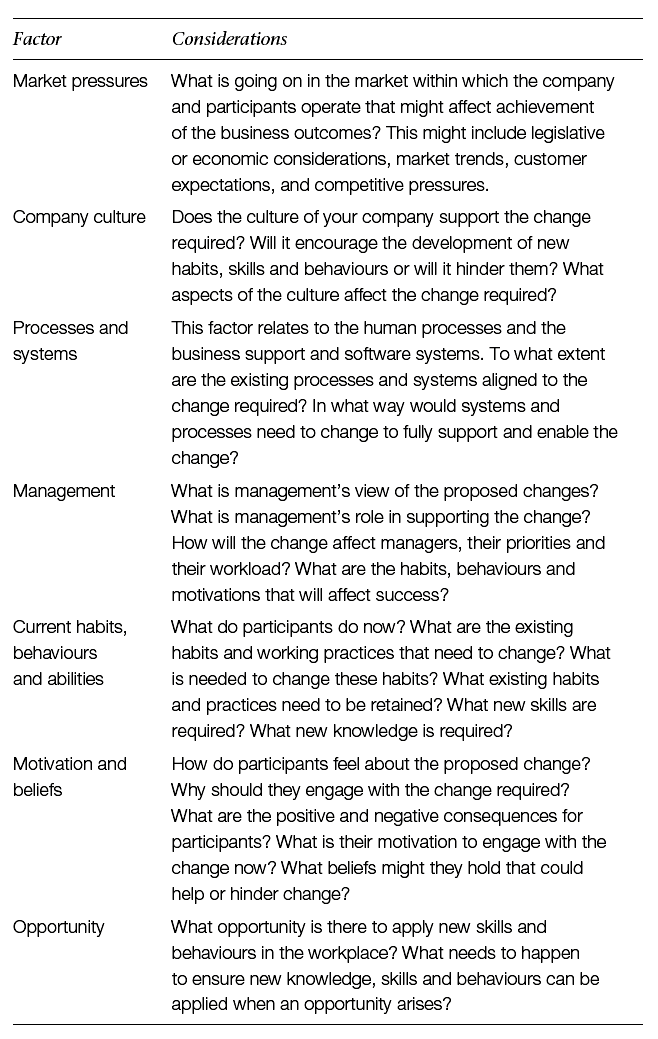
Quantitative and qualitative research
Your research around the factors identified above requires both quantitative (from ‘quantity’) and qualitative (from ‘quality’) approaches.
QUANTITATIVE RESEARCH
What is it?
The process of measurement is central to quantitative research. The result is data that are often numerical such as statistics and percentages.
Use it to:
- identify how prevalent an issue or situation is by examining facts;
- measure the incidence of various views and opinions in a chosen population or sample;
- project results to a larger population;
- find out whether there is a consensus on a particular issue;
- give precise and assessable expression to qualitative ideas.
QUALITATIVE RESEARCH
What is it?
This approach is used when data can be observed but not easily or empirically measured. It deals with descriptions rather than numbers.
Use it to:
- gain an in-depth understanding of human behaviour and the reasons that govern such behaviour;
- provide insights into the setting of a problem;
- investigate ‘Why?’ and ‘How?’ around choices of behaviour, approach and decision making;
- understand the meaning of the conclusions produced by quantitative methods.
Consider a customer service department. A training need has been identified around the business outcome of increasing revenues and customer loyalty. Before defining learning outcomes for the training, some research is conducted:
This list is not exhaustive and some of these research elements may have been investigated as part of defining the business outcome and measures of success. A key priority for you is to define what you need to research to ensure that your training needs analysis is complete, objective, practical and focuses on identifying what is needed to ensure learning transfer.
Ground rules for effective research
Whilst your context, situation and research needs will vary there are a few ground rules that will ensure that the research you conduct is effective.
Sustainable behaviour change
As so much business training is focused on creating sustainable behaviour change your research must recognise and address this. A useful way to consider what is needed to bring about behaviour change is to look at the relationship between emotions, cognitions and behaviour:
Cognition refers to awareness and perception whilst behaviour is defined as the way an individual reacts to their environment. These two topics are often the focus of a needs analysis. But for change to be sustainable the participants’ emotions about what they are being asked to do – their beliefs, motivations and feelings – must also be considered. This is often not investigated in needs analysis but if emotions do not support the learning, and the transfer of that learning, then change is unlikely to occur.
For needs analysis to be effective where sustainable behaviour change is the objective, a framework is required that takes account of all the contributing factors.
A framework for your research
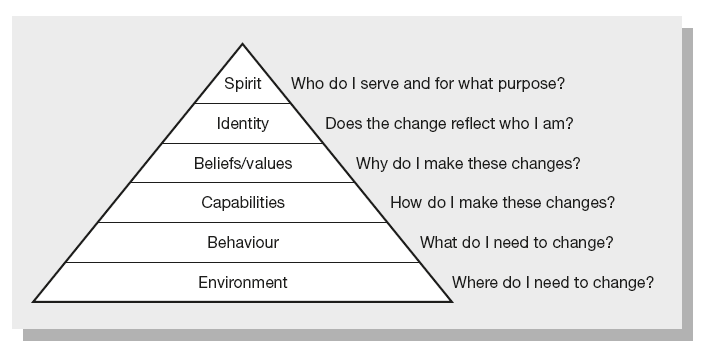
Figure 5.1 The NLP logical levels of change
Source: Robert Dilts (1990) Changing Belief Systems with NLP, Meta Publications
Individuals engage in behaviours and change behaviours for a number of reasons and a framework to structure your research is useful to ensure you identify the contributing factors both to existing behaviours that might need to change and to creating the new behaviours that you want to see.
The NLP logical levels of change model (see Figure 5.1) provides a framework to structure qualitative research when behaviour change is required. Created by Robert Dilts and based on the work of cultural anthropologist Gregory Bateson, the logical levels model is used to help inform our questioning to understand what is needed to bring about sustainable behaviour change.
The model depicts a hierarchy with the lowest level (environment) being the easiest to change:
- Environment: the physical environment and the people with whom we interact. Sometimes the environment within which we work presents obstacles and barriers to change. We may have an office layout that does not support effective interpersonal communication, a hierarchy that makes it difficult to make decisions quickly or a computer system that increases the administrative overhead in our job. All of these are examples of environmental obstacles.
- Behaviour: this relates to what people think about as well as their actions. People often act in response to what they are thinking and so the behaviour level is important as it can provide clues as to what people are focusing on when they act now. This helps us consider what needs to change in their thinking to support new behaviours and skills. The behaviours people engage in will either support or detract from achieving the change required.
- Capabilities: what skills and abilities do people have now or need to develop to support the change required? Capabilities require practice to develop competence and confidence in them. If you need to develop new capabilities you need to build the opportunity to practise into your business training.
- Beliefs/values: values and beliefs drive behaviours. They are our ‘personal policies’ that either limit or support change. If a person has a belief that they either cannot change or that the required change goes against a value then they are likely to resist and avoid change. No amount of tools and techniques taught in training will overcome a limiting belief or conflicted value. Surfacing beliefs and values provides a powerful insight into what might hinder long-term change.
- Identity: Who you are is not always what you do. Identity is about your sense of self and the extent to which you reflect that sense of self in the way you live and act. Identity relates to what kind of person you are.
- Spirit: This is about your purpose, mission and ethics. As the highest of the logical levels you may rarely touch on this and it is personal to each individual.
How many of us have designed and delivered training that focused largely on behaviours, on teaching tools and techniques without adequate time to practise (develop capability) or address any limiting beliefs that might prevent the behaviours being implemented?
Intrinsic to this model is the notion that ‘whatever is on top runs everything underneath’. This means that if you make a change at a lower logical level in the model but the problem is at a higher level, any change is unlikely to be sustained over time.
How can you use this in your research? This model can inform the qualitative questions that you ask of participants during your research. These questions can be constructed to elicit information around each of the logical levels to diagnose where you need to help someone change if that change is to be sustainable. Whilst you may not often work at the levels of identity and spirit, you can and should be researching the other logical levels for enablers and barriers to the change you need to see.
In our customer service example we might conduct research on training participants that uses the logical levels model to probe for information as follows:
- Environment:
- How does the office layout and environment support or detract from a positive team culture and the timely sharing of information?
- What would make the office environment more effective?
- Behaviour:
- What are participants thinking about as they engage in customer service calls?
- What are the behaviours and thought processes that occur now when a call is received or an outbound call is made? How does this affect the result?
- What new behaviours will support the change in result that we want to achieve?
- Capability:
- What capabilities are used by participants now and how? What is the result?
- What do participants need to be able to do that they do not do now?
- What would prevent or support the practice and development of these capabilities in the workplace?
- What support do participants need from managers and others to reinforce and develop the new capabilities?
- Beliefs/values:
- How do participants feel about their role? What’s important to them about their customer interactions?
- How do they feel about the changes needed?
- What do they believe about the new skills and their ability to apply them?
- What do participants’ managers believe about the proposed changes and their role in supporting them?
- Identity:
- To what extent do the changes required align with the existing culture of the business?
We might also use the logical levels to inform our research of customer views: what do they believe about us and what do they value in their interactions with our customer service team?
Knowing that ‘whatever is on top runs everything else’ we will focus on surfacing and challenging any limiting participant beliefs around the changes needed and the capabilities that must be developed. Surfacing and working with these beliefs will help ensure that the skills we need to develop will be applied after the training. This extends to working with any limiting beliefs that participants’ managers might hold that would become a barrier to their active support after the training.
Research methods
There are a number of methods available to gather research data. Often, a combination of methods is required to build a comprehensive picture that informs your needs analysis with both quantitative and qualitative data. Research must be objective and be based on input from credible sources. You need to balance these absolute needs with the time, cost and convenience of gathering the data. Remember that flawed or incomplete research may have a dramatic negative impact on your ability to achieve the required business outcomes through your training.
The table summarises the most popular research/data collection methods.
Sampling: Choosing who to research
Just as important as selecting the right method(s) is your choice of respondents. You are looking to match the sources of data to the purpose and needs of the assessment. It is likely that you will access different sources of input: stakeholders, managers, participants, customers, experts, high performers and low performers.
Sampling is necessary because there is often not enough time, money or labour to research everyone related to a training need. Sampling is a shortcut method for investigating a whole population and it works by applying a strategy whereby you research smaller groups of the target research population(s) to obtain a representative and statistically valid view of reality.
Your sampling strategy defines how many people will participate in the research and how they will be chosen. You are looking to eliminate any prejudice that could skew the results of the research. Generally, the larger the sample size the more accurate the representation of reality. Sample size will be a balance between the desire for a valid sample size and the constraints around time and resource that are partially determined by your choice of research method.
The sample should be representative of the total population to be trained. In most cases you will have participants that are spread in a way that can be depicted by a normal (bell) distribution curve (see Figure 5.2).

Figure 5.2 The normal distribution curve
If you are training a team of people who are performing a task now and your objective is to increase their performance, the normal curve predicts that the large majority (68%) will be performing around the average mark with an equal proportion performing below the average and above the average. When sampling participants, you want to include people from across the whole performance spectrum.
In situations where you are looking at performance (performance appraisals within a department or developing skills in a particular job role) make sure you consider the spread of performers (low, average and high) in your sample.
There are three main types of sampling strategy to choose from:
- Random: this is the least biased of the methods as each subject in the total population has an equal chance of being selected. This is often implemented by assigning a sequential identification number to every member of the target population and selecting respondents by using a random number table.
- Stratified: this method is useful when you have a population that comprises different groups (perhaps different geographical locations, functional roles, levels of experience, gender). It enables you to divide the total population into its sub-groups and sample a number of respondents from each sub-group in proportion to its part of the whole. Ideally, sampling within each sub-group would be random.
- Judgemental sampling: you choose the respondents based on criteria such as their availability, understanding of the task or needs, or ease of access. Whilst this is often a popular sampling strategy you must be aware that it may not be an accurate representation of the whole group because it is, by definition, not a random sample.
Summary
Practical research is the foundation for an objective and effective needs analysis. Following these tips will ensure your success:
- The starting point for research should be a clear understanding and articulation of the desired business outcomes and success measures.
- Take a whole system approach – do not restrict research to what needs to be trained but consider what the barriers are to achieving the business outcomes.
- When researching around topics requiring behaviour change, use the logical levels model to ensure you understand all of the facets that impact on sustainable behaviour change, including beliefs.
- Choose a research method or combination of methods to give credible, objective and comprehensive data.
- Consider your sampling strategy. Ideally this should be as large a sample as possible and chosen randomly to be as representative of the whole as possible.




